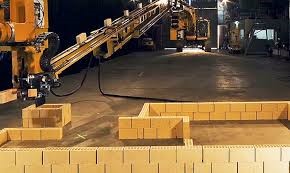THE FUTURE OF ROBOTIC LABOUR
By Deniz Kaya
With new advances in technology, we see that jobs which otherwise would be performed purely by human labour, are slowly being replaced by robotic labour. On one side, as we can see this as a great development, giving cheaper prices to consumers due to lower costs of production, more efficient industries that can invest into further advancements; in short, great for the firms which take part.
However, on the other hand, we see a great amount of protest, especially from the many people which are displaced from their previous jobs. Factory workers, are the most well known, but this problem spills into practically every industry.
- Instead of cashiers, we see that ‘Create Your Own Taste‘ kiosks are introduced, as done by McDonalds.
Hadrian X; The Robotic Bricklayer
- As an alternative to bricklayers, the Hadrian X, developed by Fastbrick Robotics, that can lay 1,000 bricks in one hour.
- No more superstore shelf stockers, as they can now be replaced by Tally, as created by Simbe Robotics, described as ‘the world’s first fully autonomous shelf auditing and analytics solution’.
The list goes on, as does the number of people that are affected, with a shocking 6% of all US jobs to be eliminated by robotics by 2021. And as the number increases, so does the number of people who want change and a solution to the problem.
The expectation of anger and perhaps even revolt within the population is not only a vague prediction, but is already a big enough of a issue that the main people that create these advancements are already preparing for the repercussions of their actions.
The billionaires of Silicon Valley are already preparing for the worst, buying up bunkers, supplies, and other doomsday gear, in preparation for the day, they fear a revolt will occur.
Steve Huffman, the co-founder and chief executive of Reddit, told The New Yorker that he believes more than 50 per cent of billionaires in the Californian tech hub are preparing for the worst.
As an example, Antonio García Martínez, a former Facebook product manager, recently purchased five acres on an island in America's Pacific Northwest. His island home features generators, solar panels, and weaponry, Business Insider reported.
Luckily, with billionaires creating problem, we also have a couple solving them. Bill Gates, has suggested that robots who take part in human activities should pay taxes. The idea is that the money can then be invested into jobs that humans are more suited in, such as care of the elderly, teaching, etc. In addition to this, tax revenue should be more secure as robots are unlikely to go against high tax rates and to take part in tax avoidance.
Gates says that combating inequality will require large amounts of excess labor to be used to help those on lower incomes, that robots will free up this labor and that the step for the necessary changes must come from governments because business cannot or will not do this of their own accord.
In recent news, this exact problem has been seen within British politics, as Jeremy Corbyn, of the labour party, says that automation is a ‘threat’ to workers.
He seconds the view that, ‘Robotics could make so much of contemporary work redundant,‘ but he placed a distinct focus on the fact that the development of robotics isn’t bad on its own but is when, ‘In the hands of the greedy’, so, for example, the billionaires of Silicon Valley.
With the knowledge that further development of robotics is hugely beneficial when used, but only to the group we want it to be beneficial to, the main issue for the future will be to see how this issue plays out and whether the revolutions against technology, as currently predicted, will truly be as much of a ‘revolution’ as is expected.
